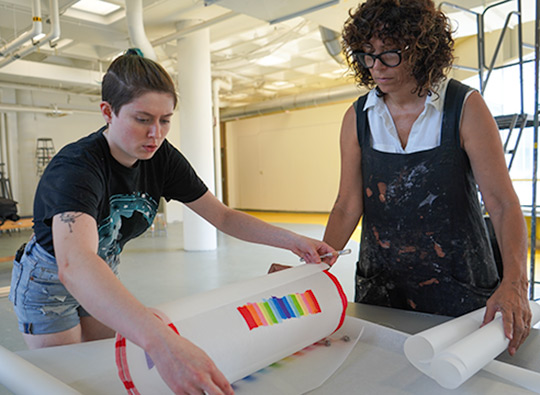Japanese ‘Nebuta’ inspires paper lantern sculptures created at Alfred Summer Arts Festival workshop

Large paper lanterns, depicting colorful birds, are being created in the Foundations space of Harder Hall throughout this week’s Alfred Summer Arts Festival: Making Meaning in an Uncertain World, which opened Sunday, July 10, and runs through Saturday, July 16.
ALFRED, NY – Large paper lanterns, depicting colorful birds, are being created in the Foundations space of Harder Hall throughout this week’s Alfred Summer Arts Festival: Making Meaning in an Uncertain World, which opened Sunday, July 10, and runs through Saturday, July 16. Sculptor George Ferrandi is overseeing morning and afternoon workshops each day this week, in which participants are creating lanterns which will be illuminated and displayed in a Friday evening parade in Alfred.
The lanterns, some which are more than six feet in height, are inspired by large-scale paper lantern sculptures created for parades held during “Nebuta,” a large festival held each summer in Japan. Workshop participants create their lanterns by constructing a frame from lightweight wire bound together with embroidery floss. The framework, or “grid” is then “skinned” with lightweight white paper, each cut to the form of each space in the frame and then secured with glue.
Once the lantern is completed, it is painted with water-soluble dye that, once lit from within, results in a brilliantly colorful sculpture. In Japan, the lanterns are also called Nebuta and serve as floats for the festival parade.
Approximately a dozen bird lanterns will be displayed during Friday’s 8:30 p.m. “Becoming Birds” parade down Main Street, held as part of the Summer Arts Festival closing ceremonies. Also displayed will be about 30 smaller lanterns made during a festival kick-off ceremony Sunday, and about 45 more made Thursday (July 14) during first-year student orientation.
Ferrandi, who splits her time between Brooklyn, NY, and Sunbury, PA, has a background in sculpture, having received her BFA from Virginia Commonwealth University and her MFA from Ohio State University, both with concentrations in sculpture. She says that since 2010, her artwork has focused on social practice; since 2015, she has been developing “Jump!Star,” an interdisciplinary program that uses art, music, and dance to inspire the creation of traditions to mark the transition of our North Star, currently Polaris, to the star Gamma Cephei, approximately 1,000 years from now. The change in our guiding star occurs as the axis of Earth’s rotation changes, altering the alignment of the stars with the planet.
Jump!Star promotes global celebrations marking eventual transition of one guiding star to the next. Throughout a 26,000-year cycle, referred to as “The Great Year,” there will be a transition from Polaris to 11 other stars which will serve as North Stars, or “pole stars.” At the end of The Great Year cycle, Polaris will return as Earth’s North Star. Ferrandi has developed back stories for each of these eventual pole stars, based on how each has been regarded throughout time in various cultures.
People across the globe have a propensity for “star parties”—we do, after all, celebrate the New Year, which marks the end of Earth’s rotation around its closest star. Jump!Star endeavors to use art to create celebrations of the transition of Earth’s pole stars. At the same time, these celebrations seek to inspire discussion about the necessary changes—in the way we produce food, or how we approach Earth’s changing climate, for example—needed to ensure the survival of our planet. Nebuta-inspired lantern sculptures have been created and displayed at various events across the country organized by Jump!Star.
“We are developing ways to commemorate Polaris,” Ferrandi says. “What we are doing is planning and putting rituals in place. It’s a way to imagine the future.”
In photo above: George Ferrandi (right) gives instruction to Mia Heidenreich during a workshop creating Nebuta-themed paper lanterns.
